The Best Lake Trout Fishing Rigs (Complete Guide With Pictures)
UPDATED 03 NOVEMBER 2023
by Robert Ceran
Lake trout are the largest native trout species in North America (though technically they belong to the char family), and often grow to sizes north of 30 pounds.
That, and their beautiful marbled markings, make them one of the most sought after freshwater game fish among anglers.
However, catching lake trout is more challenging than targeting most other freshwater species.
They love cold water, and spend most of the year in the deep water zones of big lakes, where they can be hard to find unless you have a fish finder and/or a local guide to help you.
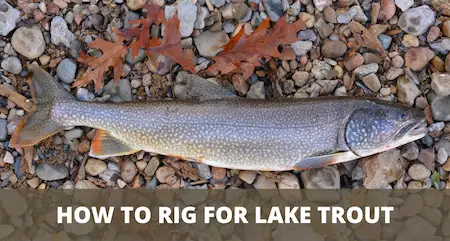
Also, if you want to catch lake trout successfully, it’s important to gear up correctly, and this includes having the best lake trout rigs at your disposal.
How do you rig for lake trout?
The best lake trout rigs are:
- Jigging rig
- Stinger rig
- Tube jig with stinger hook
- Dead bait rig
Apart from the dead bait rig, all of these rigs are intended to be fished vertically, and thus should be used from a boat, or fished through the ice.
While it’s possible to catch lakers from shore, you’ll get much better results using a boat plus sonar to find lake trout, and by targeting the right depth to catch them.
The rigs described here don’t include lake trout trolling rigs, which are covered in a separate article. Now let’s dive into the details, and look at each of these lake trout rigs more closely.
Jigging rig for lake trout
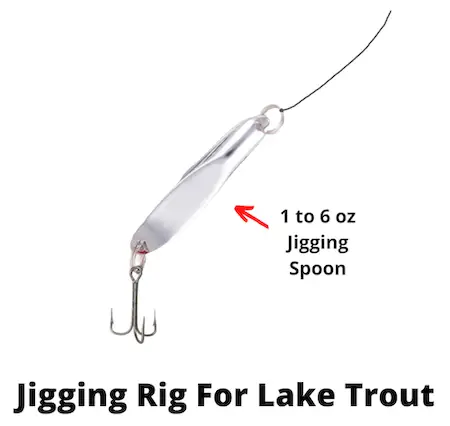
This is one of the simplest while at the same time highly effective lake trout fishing rigs. It’s a great rig to explore new spots quickly and easily.
How to tie it: If you’re using monofilament as your main line, you can tie that directly to a large jigging spoon (the best line strength to use for this with mono is 10 to 15 lb test).
However, if you’re using braid as your main line, you should tie either a fluorocarbon or monofilament leader.
We recommend using a 20 lb test braid as your main line, and then tying a 2 to 3 foot fluorocarbon leader (10 to 12 lb test is ideal for this).
The advantage of using a braided main line is that it doesn’t have any flex, which means you’ll have maximum sensitivity in terms of being able to feel everything that’s going on with your jigging lure, even when you’re fishing very deep.
The fluorocarbon leader, on the other hand, comes with the advantage of having a very low visibility in the water, giving your presentation more stealth.
The best lake trout jigging lures to use are extra large jigging spoons and tube jigs (all the way up to 6 oz.). When it comes to targeting lakers, you really shouldn’t be shy about using oversized lures, since they often feed on big forage.
When to use it: This is a great all around rig to use for lake trout fishing, since it’s so easy to set up, and you can have it in the water in next to no time.
This rig is designed for vertical fishing, and so needs to be used from a boat. Of course, you can also use it for lake trout ice fishing, which by definition is vertical fishing.
How to use it: If you’re driving around a new lake on a boat, and spot some promising signals on your fish finder, drop down your jigging rig and see if you can get them to bite.
The ideal jigging cadence is to quickly raise your jig up about 3 feet, and then slowly lower it down again. Most bites usually come while you’re lowering it, so be ready for that.
Stinger rig for lake trout
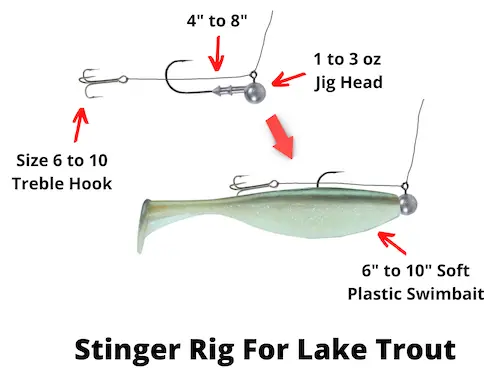
This rig is ideal for vertical fishing, and comes with the advantage that it enables you to improve the hook up rate while using very large swimbaits.
How to tie it: Start with a 1 to 3 oz jig head (either colored or plain), and tie a 4 to 8 inch line to the eye of the jig head.
The best line to use for this is 12 to 15 lb test fluorocarbon, which is almost invisible in the water, yet highly abrasion resistant. Next, tie a size 6 to 10 treble hook to the end of this line (this is your stinger hook setup) .
The length of the line connecting the jig head to the swimbait stinger hook depends on the size of the swimbait you plan to use.
We suggest starting with a 6 inch swimbait, and then testing larger sizes up to 10 inches or even longer. When using extra large swimbaits, you may also want to add a stinger hook at the front of the bait.
Most people are surprised by how big lake trout lures are, but you need to keep in mind that they are among the most aggressive predators in North American lakes, and regularly eat bait fish that are bigger than 15 inches long.
So don’t hesitate to try very large lures (such as muskie size swimbaits), especially if you know there are big lakers in your fishery.
When to use it: The stinger hook rig is a great option when you’re getting a lot of short strikes, since the stinger hook improves the hook up ratio by a lot.
Lake trout have very hard mouths, and are notorious for coming off the hook easily. So having that treble stinger hook on your rig helps to increase the chances of hooking fish successfully.
How to use it: Fish the stinger rig very similar to how you would fish a regular jigging rig – drive around the like until you spot lakers on your fish finder, and then drop your lure presentation down to the right depth, and jig it up and down until you get a bite.
Tube jig with stinger hook for lake trout
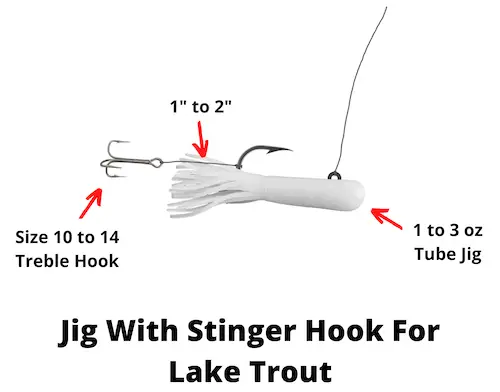
Tube jigs are among the best lake trout lures, and especially the white tube jig for lake trout is favored by many anglers, accounting for more fish in the boat than any other lure.
However, just like other lures with a single hook, tube jigs suffer from the disadvantage of resulting in a low hook up ratio when it comes to lake trout fishing (due to the hard mouths of these fish).
But you can fix this issue by tying a stinger hook to your tube jig, which is exactly what we’ll cover here.
How to tie it: Here’s how to rig a tube jig for lake trout to avoid short strikes: start by tying a 2 inch piece of fluorocarbon line (around 10 to 15 lb test) to the bend of the hook on your tube jig.
Next, tie a size 10 to 14 treble hook to the end of this line (which is your stinger hook). Finally, tie the eye of the tube jig to your leader, and you’re good to go.
When to use it: This is a great jigging setup for lake trout, and can be used all year round, both during open water and ice fishing season.
White color tube jigs are most effective at triggering lake trout bites, but chartreuse comes in a close second, and you should also experiment with other colors, especially when the bite is slow.
How to use it: Fish the tube jig with stinger hook just like any other jigging lure. Also, you may want to try experimenting with changing the length of the line of the stinger hook, to see how this affects the hook up percentage.
Dead bait rig for lake trout
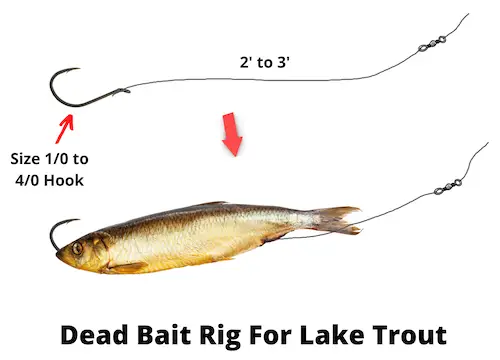
This is one the best bait rigs for lake trout, and works well for both vertical fishing, as well as for fishing from the shore.
How to tie it: Start by tying a size 1/0 to 4/0 circle hook to your leader. While this may seem like a very large hook size to use in freshwater, you’ll need it with full size herrings or other bait fish over 10 inches.
The great thing about using a circle hook is that it rarely hooks lake trout deeply, and most of them get hooked right in the corner of their mouth, which is ideal in case you want to release them alive.
After tying your hook onto the leader, the next step is to thread the leader line from head to tail through your bait fish.
The best way to do this is with a bait needle – tie your leader line to the bait needle, and then poke it through the fish, and pull out the leader on the other side.
The last step is to tie the leader to a swivel connecting it to your main line, and you’re good to go.
You can also tie a loop at the end of your leader, and then use a snap swivel to attach it to your main line, which is easier if you need to rig a new bait fish later on.
When to use it: The dead bait rig is a great option if the lakers are ignoring your lures.
Lake trout are very partial to eating dead bait fish, and dead bait is an excellent bait for catching them when they don’t want to bite your jig or swimbait.
This rig is also the best option when you’re fishing for lakers from shore.
How to use it: Cast your baited rig out from shore with a baitfeeder reel, and wait for a lake trout to eat your bait.
When fishing from a boat, lower your bait down to the correct depth and wait for a strike.
You shouldn’t try to set the hook instantly when you get a bite on this rig, since it usually takes a while for the lake trout to get the bait inside its mouth.
So wait for a few seconds and then reel in until you feel resistance before setting the hook.
What is the best rig for lake trout?
The best rig for lake trout depends on the circumstances you’re fishing in, but all in all the tube jig with stinger hook is the best choice for vertical fishing.
This makes it ideal for jigging from a boat, as well as the best ice fishing rig for lake trout.
If you notice that lake trout are hunting very large bait fish (such as full size herring, ciscoes or whitefish), it often helps to upsize your presentation.
In that case the stinger rig combined with extra large swimbaits around 10 inches can be the best rig for lake trout fishing.
Finally, if you’re fishing from shore, the best option to use is the dead bait rig, since that allows you to cast out your rig far enough, and fish it stationary, while waiting for lake trout to pass by.
